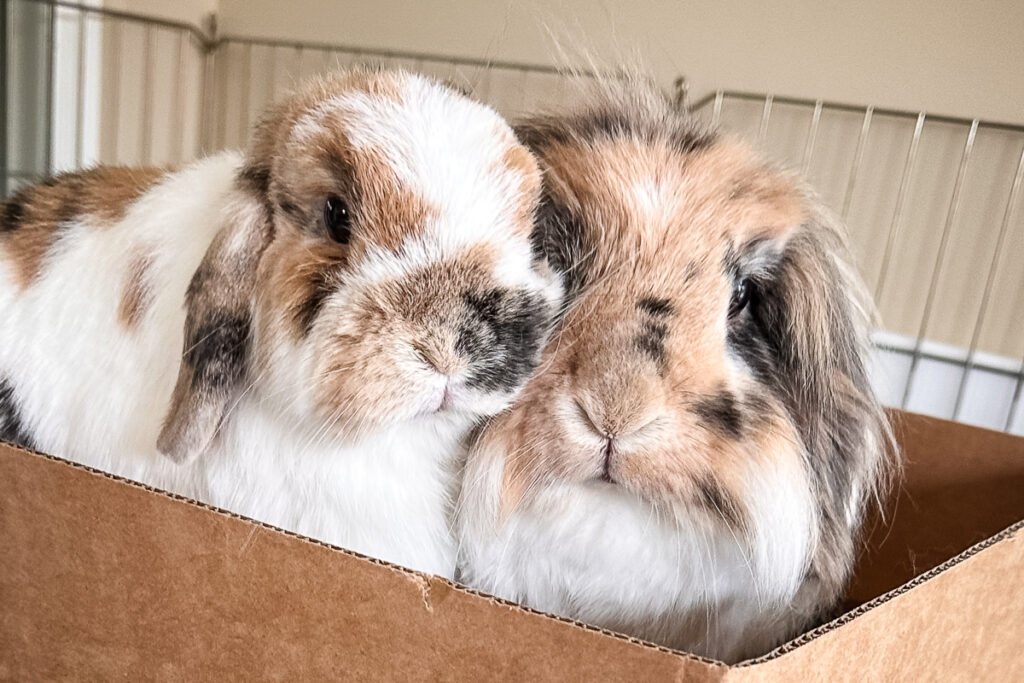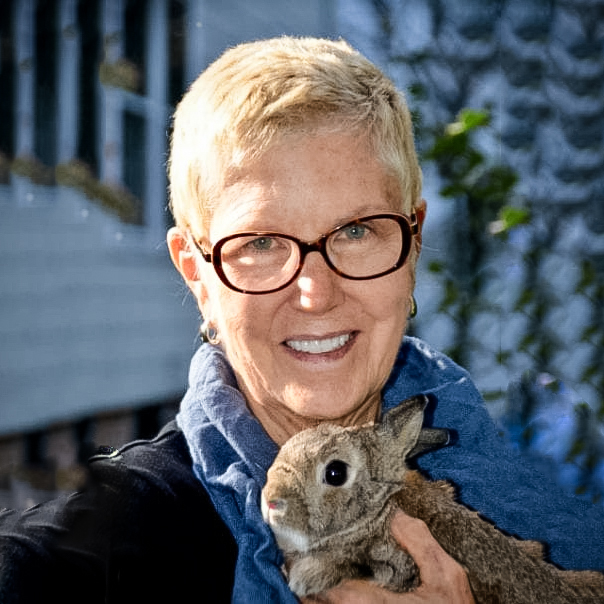Responsibility involves providing proper housing, nutrition, grooming, and veterinary care.
Domestic rabbits are delightful companion animals. They are inquisitive, intelligent, sociable and affectionate, and well-cared-for indoor rabbits can live for seven to 10+ years. Adopting a rabbit, therefore, is a long-term commitment.
RABBITS AND CHILDREN
Our culture is so filled with images of children and rabbits together (the Easter Bunny, Peter Rabbit, etc.) that many parents see rabbits as low-maintenance starter pets for kids. Nothing could be further from the truth. Rabbits are physically delicate and fragile and require specialized veterinary care.
Children are naturally energetic and loving. But “loving” to a small child means holding, cuddling, or carrying an animal around precisely the things that frighten most rabbits. Rabbits can’t cry out when distressed. Instead, they may start to scratch or bite to protect themselves from well-meaning children. Thousands are abandoned to animal shelters for this reason. Many rabbits are also dropped accidentally by children, resulting in broken legs and backs. While rabbits may be appropriate family companions, an adult should be the primary caretaker.
RABBIT HOUSING & RABBIT EXERCISE
Many people think that rabbits don’t require much room for housing or exercise. Not so! Rabbits have powerful hind legs designed for running and jumping. They need plenty of out-of-cage exercise time, as well as a pen or cage that allows them to move freely. The minimum recommended cage space for a single rabbit is 2’ x 2’ x 4’. Although wire-bottom cages are common, they can ulcerate a rabbit’s feet. If you have a wire cage, cover the bottom with a piece of wood or corrugated cardboard. Better yet, use a pen.
Your rabbit needs a safe exercise area with ample room to run and jump, either indoors or out. Any outdoor area should be fully enclosed by a fence. Never leave a rabbit unsupervised outdoors even for a few minutes! Cats, dogs, and even predatory birds can easily get around fencing material. Also, rabbits can dig under fences and get lost. Indoor housing is essential. Domestic rabbits can die from heart attacks at the very approach. of a predator. Other outdoor concerns: fleas (anemia, West Nile virus), ticks, RHDV2, Baylisacaris procyonis (raccoon roundworm), and flystrike.
Intact male and female rabbits must be separated by sex and housed separately. “Accidental” litters occur in shelters with distressing frequency. A doe can have a litter every 30 days and can get pregnant within 30 mins. of giving birth. Immature rabbits can be hard to sex with. Ask for expert help if you have any doubts.
You can rabbit-proof an indoor area by covering all electrical wires and anything else your rabbit is likely to chew. Recommended exercise time for indoor rabbits is several hours per day.
Place rabbits away from extreme heat. Avoid placing rabbits on the top tier of cages if possible -especially in summer.
Avoid placing rabbits in the same room as barking dogs if possible. Rabbits usually adapt quickly to barking heard from a distance. Avoid placing rabbits across from (or in full view of) cats.
Litter-trained rabbits are more easily adopted. Shelter rabbits will usually use litterboxes readily if the box is placed in the corner the rabbit has chosen for urination. Line litterbox with a section of newspaper and fill with grass hay. Dump daily. Avoid pine and cedar chips as bedding or litter material; aromatic phenols can potentiate liver enzymes and irritate the respiratory tract.
A cardboard “hidey box” placed in the cage can make a rabbit feel more secure. However, this may increase territorial behaviors – particularly in unspayed females. Boxes are most useful in wire cages, where the rabbit has no other means of hiding himself.
Converted dog runs make great rabbit exercise areas. Use donated carpet scraps (or inexpensive, rubber-backed runners) to offer the rabbit traction for running and jumping.
Rabbits love “projects” – i.e. objects in their environments that they can move and manipulate. These provide stimulation and exercise. Offer plain brown, corrugated cardboard boxes for chewing and “interior desecration.” Plain, non-toxic wooden or hard plastic baby toys can also be appropriate “toys” for rabbits.
DIET FOR RABBITS
- The 3 most important foods for a rabbit are hay, hay, and HAY! (such as Timothy or Brome), which keeps the intestinal tract healthy; feed it free-choice, daily. Contrary to popular belief, rabbits do not need salt licks, vitamins, or hard wooden objects to wear their teeth down. Teeth are kept worn to a proper length by the silicate and lignin content of grass and grass hays. Do not offer rabbits plants, vegetation, or tree branches unless you are sure they are not harmful.
- Limited pellets (plain only! no seeds, nuts, colored tidbits): 1/4 cup, per 5 ft. of body weight per day
- Dark -green leafy veggies daily if possible (good job for volunteers!). Good veggies: all leaf lettuces, dandelion greens, kale, collards, turnip greens, mustard greens, parsley, cilantro, basil, Avoid: cabbage, broccoli, cauliflower, brussels sprouts, spinach.
- Limited amounts of sweet veggies such as carrots.
- Occasional treats in very low quantities: a slice of apple, a slice of banana, a -few, hulled sunflower seeds, 2-inch piece of carrot. For more frequent treats, use fragrant herbs such as cilantro, parsley, arugula, basil, et al. Do not feed bread or other high-carbohydrate foods, as they can. lead to intestinal dysbiosis.
- Freshwater, changed daily. A crock is preferred; If you use a water bottle double-check to see that steel ball in the bottle is working properly each the time you hang the bottle. Bowl (changed daily) encourages more drinking, but bowl. must be heavy crock to prevent tipping.
LITTER TRAINING
Rabbits are very clean by nature and will do their best to keep their living quarters clean. Most rabbits will choose one corner of the cage as their bathroom. As soon as your rabbit’s choice is clear, put a newspaper-lined litter box in that corner; fill it with Timothy hay (or any other grass hay not alfalfa). Pelleted-newspaper litters are also acceptable. If the litter box is changed daily, your rabbit’s home will stay fresh and odor-free. Don’t use pine or cedar shavings! The fumes may affect your rabbit’s liver enzymes, which can cause problems if the animal needs anesthesia for surgery. Avoid using clay cat litters (both clumping and non-clumping); these may result in respiratory or gastrointestinal problems.
INDOORS OR OUTDOORS?
Many people think an outdoor hutch is the best way to keep a domestic rabbit. Rabbits, however, are highly social animals, and a backyard hutch forces them to live in unnatural isolation. Furthermore, rabbits can die of heart attacks from the very approach of a predator or vandal. Domestic rabbits do best indoors where they have plenty of interaction with family members.
HANDLING AND HOW TO CARE FOR YOUR BUNNY
- Pick up your rabbit by supporting his forequarters with one hand and his hindquarters with the other—failure to do so can result in spinal injuries to the rabbit. Never pick up a rabbit by his ears; this can cause very serious injury.
- Brush your rabbit regularly with a soft brush to remove excess hair and keep his coat in good condition. Ask your veterinarian how to clip your rabbit’s nails.
- Rabbits should be spayed or neutered by a veterinarian experienced with rabbit surgeries. If this is not possible, include spay/neuter as part of the adoption contract, and take a deposit to be returned upon presentation of proof of surgery. Besides preventing accidental litters, spaying prevents uterine cancer (which can reach 50-80% as rabbits age), and neutering reduces spraying and other hormone-driven behaviors. To find a qualified rabbit veterinarian, search the House Rabbit Society web page at www.rabbit.org.
- Rabbits should not be housed with other rabbits unless all are spayed/neutered and are introduced in neutral territory under careful supervision. Introductions are often difficult and injuries can result.
- If your rabbit stops eating or moving his bowels for 12 hours or longer or has watery diarrhea, seek expert veterinary care immediately.
- If possible, talk to the rabbit calmly and stroke him daily. Rabbits are highly social animals who thrive on attention and social interaction. Many rabbits are very overtly affectionate and will nuzzle and lick their handlers. Others are shyer and more “laid back.”
- Do not approach the rabbit directly in front (unfortunately, shelter cages leave you few alternatives). Rabbits have laterally placed eyes and cannot see up close, directly in front of themselves.
- When working with an unfamiliar rabbit, pat the rabbit gently between the eyes, until he relaxes, before picking him up. Never attempt to lift a rabbit who is struggling. Rabbits can easily break their own backs attempting to get away from perceived predators (us!).
- Lift the rabbit by supporting his hindquarters and forequarters simultaneously. If the rabbit struggles to get down once lifted, lower yourself (and the rabbit) as close as possible to the floor to prevent injury.
- Always remember that rabbits are a prey species. The more predictable their environment and the more securely they are handled, the more relaxed and sociable they become. Many rabbits relinquished to shelters have been severely traumatized in their former environments. They may have learned to survive by nipping or boxing. These behaviors can usually be eliminated by correct handling and social interaction.
- Rabbits are highly territorial, and may also attempt to nip or box when their territory is “invaded.” This is especially true of unspayed females. This behavior is entirely normal and is usually greatly reduced by spaying/neutering. If a rabbit boxes when you offer food or clean the cage, place one hand on the rabbit’s head and gently press and rub, while using the other hand to remove the food bowl, litterbox, etc.

